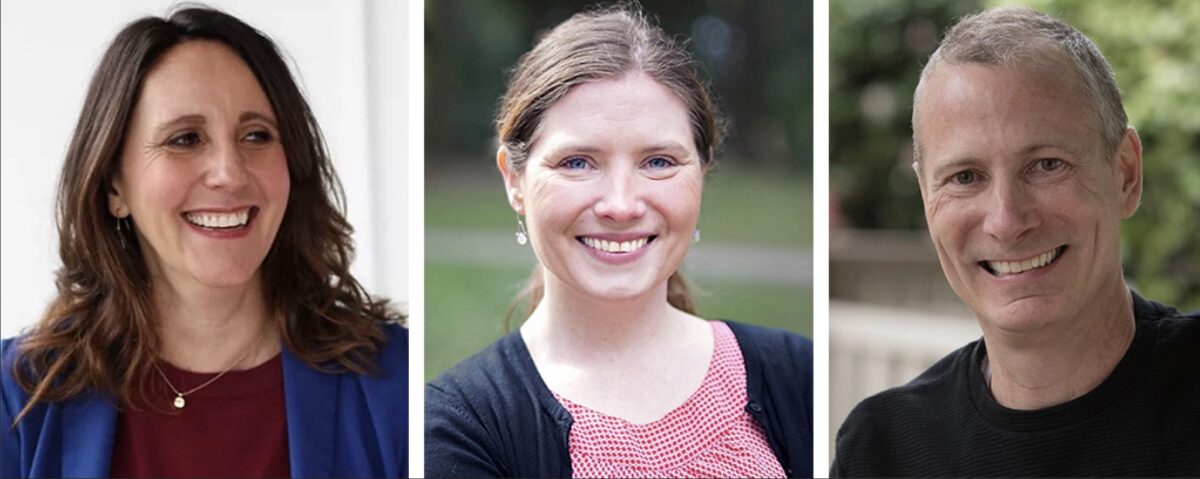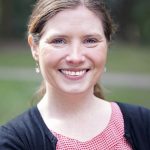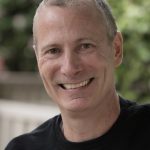
(Photos supplied by campaigns)
Welcome to the second of our four posts where we ask Portland City Council candidates about bicycling.
On Friday we heard from the top five candidates in the very competitive race for position 4 (currently occupied by Chloe Eudaly).
Today we’ll hear from position 2 candidates including: Tera Hurst, Julia DeGraw and Sam Chase.
BikePortland asked each of them the same six questions via email. Below are their responses (with some editing for brevity and clarity):
What is your relationship to cycling?
Tera Hurst:
I love to ride my bike especially with my son, admittedly we haven’t done it in a while I am terrified of him in the streets on a bike with cars, and these days he prefers his skateboard. My preferred mode of transportation is walking which is how I commute from Southeast to Old Town for work.
Advertisement
Julia DeGraw:
I used to bike commute when I lived in Sellwood and then for a brief period of time when I moved to Montavilla. I commuted to downtown for a couple years before an injury knocked me out, and, unfortunately, I never quite got back into it. I found that, when I started trying to bike commute again, the traffic had gotten substantially worse – I had several near misses from drivers clearly not paying attention, so I stopped biking regularly. My commute also changed substantially when I got a new job that required me to attend numerous meetings and events around town. Nonetheless, I still enjoy cycling for recreation.As a person who also drives, I am very mindful of cyclists. I frequently worry for cyclists when I see them on busy roads, and I wish there were safer routes for them to commute anywhere in Portland.
Sam Chase:
I love biking with my family, to get around town, and for exercise. For many years, I lived without a car, and loved how easy it was to navigate life with biking and transit options. Having a family changed that temporarily, but I plan to sell the family car as soon as the kids go to college.
Have you ever ridden a bike on a high-traffic, high-speed arterial street? What was it like?
Tera Hurst:
I have but not in a while, it is scary and feels like you are putting your life in someone else’s hands. It is hard to know if the drivers see you, I feel much better when bicycling on these roads when there are safe and differentiated bike lanes and signals that coordinate.
Julia DeGraw:
Yes! I hated it! The air quality is terrible, the traffic noise is stressful, and sometimes drivers can be overtly “anti-cyclist” in a way that feels uncomfortable at best and dangerous at worst. I’ve only ridden on these roads when I knew no other way to get where I was going and when there was a clear bike lane or large shoulder, but I still felt unsafe.
Sam Chase:
Many times. I’m comfortable in high traffic situations, but also am cautious and concerned about several close calls I’ve had. More separated lanes will make riding safer and get far more people out of cars.
Advertisement
Bicycling to work in Portland is at its lowest point in 12 years. What do you think is causing that and what are two things we can do to increase bicycling in Portland?
Tera Hurst:
I would approach this issue from two perspectives. First, we need to make it safer and easier to bike and ensure that residents have safe routes to school, their work, errands, transit, etc. Secondly, we need to use congestion pricing to recognize the full costs of driving and parking. Doing so will help reflect the costs of driving, and provide more incentives for people to ride their bike instead.
Julia DeGraw:
As I mentioned in my first answer, I took a break from bike commuting due to an injury, and in the months it took me to recover, the traffic had increased substantially. I had too many near-collisions with vehicles that I didn’t feel comfortable continuing to bike commute. There are several things we can do to increase biking in Portland, such as make more protected bikeways that are better marked and may have protective barriers, encourage employers to incentivize employees to ride to work, including offering secure bike lock areas, showers and places to easily change, and create more safe places to lock-up bicycles throughout the entire city.
Sam Chase:
Separated lanes are important not only because they are safer, but also because the feeling of being safe makes many more comfortable with bike riding. I’ll fight to create more bike boulevards that run parallel to busy streets, and separated biking options like building out the North Portland Greenway. Managing our transportation system to reduce our subsidies will help shift the cost equation on biking vs. driving. We have to look at congestion pricing options like Stockholm, London, and Singapore. That’s why I fought and won resources to do just that as a Metro Councilor.
Why is it so important for cycling to remain a high priority issue in City Hall?
Tera Hurst:
For so many reasons. First, bicycling is a mobility strategy and is key to climate action. We need to reduce the number of trips people make by car, and increase the trips we make by bike, walking, and transit. It’s a public health and livability strategy for the City. We need to view our roads as people movers not just for cars. Then I believe we will start planning differently.
Julia DeGraw:
Because every year, more people die while riding their bikes in Portland. People shouldn’t have to risk taking their lives into their hands by choosing this healthier option for their bodies and the environment. The City needs to step up its game to ensure their safety. All of our roads need to be designed for multimodal use that ensures safety for pedestrians, bicyclists, and other road users, and that also places a far bigger emphasis on transit instead of cars.
Advertisement
Sam Chase:
Portland is the central hub for our region’s economic activity and livability and will continue to show the region that embracing biking options reduces congestion and our carbon footprint at the same time.
Do you think PBOT should respond to how the pandemic has impacted streets and how we use them? If not, why not? If so, what do you think they should do?
Tera Hurst:
“I would love to see the street closures become permanent.”
— Tera Hurst
Yes, I fully support PBOT’s announcement this week that they are closing some streets to cars to provide more space for people to walk and bike safely at a distance. And it is a good trial run for how these streets operate without cars because that is our future — more space dedicated to people. As we think ahead about recovering from this global pandemic, we need to be thinking about maximizing more space for people. When I was Deputy Chief of staff to Mayor Hales we along with advocates and planners created Better Naito at first it was a pilot project, and now it is a permanent strategy that Portlanders love. I would love to see the street closures become permanent as Portlanders get used to it and more than likely fall in love with these safer mobility options, just like we have with Better Naito.
Julia DeGraw:
“Because of our rainy and cold winters, I’m not certain we can become a city where people bike commute year-round in huge numbers.”
— Julia DeGraw
In order for PBOT to respond positively to the lower traffic we’re experiencing due to the pandemic, as we begin to open up and recover from it, we will need employers to continue to allow and encourage their employees to work from home, and employers can explore staggering their employees’ schedules as they begin to go back to work to disrupt the usual rush hour traffic patterns. As Commissioner Eudaly says, traffic isn’t a problem of supply, it’s a problem of managing demand. In order to really get people out of cars, we will also need a massive investment in transit to expand its frequency and service, particularly in East Portland. Since we will be living with the novel coronavirus for the indefinite future, it will be a while before people fully return to work and businesses reopen. This is an incredible time to experiment with car-free zones. This is why I’m excited to see Commissioner Eudaly proceed with a Slow Streets | Safe Streets program with PBOT to make it easier for people to get around outside while practicing safe social distancing. I’m extremely interested in seeing how this can change how we use our streets as we adjust to living with this pandemic and once we begin to recover from it.Short term, it’s a challenging time to explore expanding transit since congregating is not possible and we’re experiencing a massive decline in revenue streams. However, long-term, a big part of the equation has to include expanding transit. Because of our rainy and cold winters, I’m not certain we can become a city where people bike commute year-round in huge numbers, which is why we need to increase and electrify transit, as well as invest in more protected bikeways and better sidewalks.
Sam Chase:
Yes. Before the pandemic, communities in Europe and elsewhere have put temporary measures for biking and walking only streets in place. Communities are more accepting of these options and more willing to give them a try when they know they are temporary. When they do give it a try, it gains a tremendous amount of support as a long-term solution.
If you were in charge of PBOT, what would you do to make cycling more attractive and safe east of 82nd?
Tera Hurst:
I would invest in bike infrastructure — safe bikeways that get people where they need to go and I would expand bike-share programs and make them free or low-cost to support residents in East Portland for bicycling to be a valuable option.
Julia DeGraw:
As a resident who lives east of 82nd, I really appreciate this question. There needs to be a comprehensive plan for creating protected bikeways and multimodal roads east of 82nd Ave. There should be connected and extensive protected bikeways going North/South and East/West throughout East Portland, going all the way to Gresham. Without a long-term vision and plan that includes funded benchmarks (or phases), we aren’t going to solve this problem with our current car-centric approach or through ad hoc projects here and there. These bikeways need to have transit hubs in mind and link to amenities like parks and greenspaces. We also need to greatly increase bike parking as we build more protected bikeways and transportation hubs throughout East Portland. As bikeways improve on the eastside, we could also expand bike-share systems like we have downtown. Lastly, we need more public-private partnerships to fund cycling and bike repair workshops led by and for culturally specific communities to truly make cycling more accessible to a broader population of Portlanders.
Sam Chase:
I would prioritize safe crosswalks, bike lanes, and bike boulevards along streets that run parallel to main arterials, including exploring acquisitions of properties that cut off streets from continuing a straight path.
Learn more about these candidates on their respective campaign websites: Tera Hurst, Julia DeGraw, Sam Chase.
Stay tuned to hear from City Council Position 1 candidates Tim DuBois, Carmen Rubio and Candace Avalos. We’ll conclude this series with responses from mayoral candidates Sarah Iannarone and Teressa Raiford.
— Jonathan Maus: (503) 706-8804, @jonathan_maus on Twitter and jonathan@bikeportland.org
— Get our headlines delivered to your inbox.
— Support this independent community media outlet with a one-time contribution or monthly subscription.





